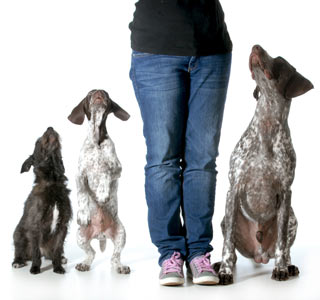Do Dogs Get Jealous?

Do dogs get jealous of each other? How about jealous of a new person, a new cat, or a baby?
The feeling of jealousy was long held by scientists to be an emotion that could only be felt when the possible consequences of losing someone was clearly understood by the jealous being. It was also usually studied in the context of romantic relationships. In other words, if you were jealous of a woman who was getting attention from your boyfriend, it was because you were able to reason what the possible end-game might be. Your boyfriend might leave you for the other woman and you would be sad and/or lose financial or other benefits that your boyfriend provides. In this case, jealousy might motivate you to work to get your boyfriend's attention back. Under this view, animals and young people would not be capable of feeling jealousy.
However, dog-lovers and mothers of small babies cannot be convinced that their charges don't feel jealousy, no matter what scientists say. They base this on their own unscientific but highly-repeatable observances that dogs and babies certainly act jealous when their primary caregivers give attention to another dog or baby.
Research on Jealousy in Human Infants
Scientists have decided to try and prove that there is a form of jealousy that can develop without the complex ability to reason out consequences. If this is the case, then non-verbal babies, dogs, and other social animals may possess a more primitive form of jealousy. If they see their primary caregiver's attention straying from them to another being like them, they may be able to feel this primitive form of jealousy and work to regain the caregiver's notice. Scientists feel that this probably developed in order to guard the individual's access to resources.
To test whether or not this basic form of jealousy may be present in babies, scientists developed a study model where they had mothers of babies less than six months old pay attention to a doll that cried like a real baby. Then, the mother gave her attention to a book, reading it out loud and treating it with regard. The infants displayed signs that could be interpreted as jealousy such as crying, acting distressed, touching the mother more often, and interrupting their play to watch what the mother was doing. When Mom paid attention to the book, the babies performed significantly fewer of these jealous behaviors.
Jealousy Research in Dogs
Some scientists decided to use the same research model to attempt to determine whether dogs might also feel jealous. There were 36 dogs in the research study. They were all small dogs, less than 35 pounds, because the researchers thought that it would be more dangerous if bigger dogs were used and they reacted to the experiment conditions aggressively. The owners of the dogs would play with, coo too, and pet an object while ignoring their dog in the same room. Three objects were used. One was a robotic dog that barked and wagged its tail. One was a jack-o-lantern. The third object was a book that also made some noise.
The results of the research study were that the dogs definitely reacted more when their owners paid attention to the robotic dogs. They did not react nearly as much when the jack-o-lanterns or books were given consideration. The reactions that the dogs had could be interpreted as jealous. Dogs tried to get in between their owners and the robot, they sometimes snapped at the robot, whined and barked, pushed at the owner, and pushed at the robot.
The biggest indicator that the dogs felt jealous during the experiment was that there was a statistically supportable difference in whether the dogs displayed the same behaviors when the owner paid attention to the jack-o-lanterns or books. The dogs simply did not react the same way to those objects. As was the case with the human infants, the dogs did not seem to view the objects that were different from them as a threat.
This research is interesting and exciting with regards to the emotions that dogs and perhaps other social animals are capable of. Of course, moms and dog-owners probably didn't need to read the studies to guess the results.
References
Christine Harris, C. P. (2014, July 23). Jealousy in Dogs. Retrieved from PLOS ONE: http://www.plosone.org/article/info%3Adoi%2F10.1371%2Fjournal.pone.0094597
You May Also Like These Articles:
Disclaimer: This website is not intended to replace professional consultation, diagnosis, or treatment by a licensed veterinarian. If you require any veterinary related advice, contact your veterinarian promptly. Information at DogHealth.com is exclusively of a general reference nature. Do not disregard veterinary advice or delay treatment as a result of accessing information at this site. Just Answer is an external service not affiliated with DogHealth.com.

